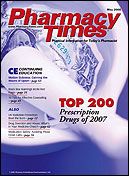Publication
Article
Pharmacy Times
Outlook: Clinical Trials
Author(s):
Ms. Farley is a freelance medical writerbased in Wakefield, Rhode Island.
Blood Pressure Vaccine on the Horizon
A small study out of Lausanne, Switzerland, treated 72patients with mild-to-moderate high blood pressure witheither a vaccine or placebo. Patients in the vaccine groupdemonstrated a strong antibody response against angiotensinII, compared with those in the placebo group?theresponse was stronger when the vaccine?s dose was higher.Chief scientific officer, Dr. Martin Bachmann, at the vaccine?sdeveloper, Cytos Biotechnology AG, noted that thevaccine was most effective in the early morning, which isconsidered the most dangerous time to have high bloodpressure, as it further increases the risk of stroke and heartattack. He says that the vaccine acts like a sponge, emptyingout at night when less angiotensin II is produced; thatway, in the morning, the vaccine can take up all the angiotensinthat is produced. Conventional drug therapiesleave hypertensive patients most vulnerable in the morning,as they have not yet taken their meds. Also, conventionalmedications seem to increase renin levels, thereby increasingrisk of kidney failure. The vaccine has no such risk.Although these results are promising, researchers agreethat more work is needed to evaluate the vaccine?s clinicalusefulness.
Positive Study Results forOsteoarthritis Drug
A phase 3 study of naproxcinod, thefirst compound in the cyclo-oxygenase?inhibiting nitric oxide donatorclass of drugs, showed that all 3 endpoints were met successfully, includingpain, function, and patients? rating ofdisease status.
The study randomized 918 osteoarthritispatients to receive naproxcinod375 mg bid, naproxcinod 750 mgbid, naproxen 500 mg bid, or placebofor 13 weeks. When compared withplacebo, 3 different doses of naproxcinoddemonstrated superiority toplacebo at weeks 2, 6, and 13. Qualityof-life scores also were superior tothose in the placebo group. Accordingto the principal investigator,Thomas J. Schnitzer, MD, PhD, ofNorthwestern University FeinbergSchool of Medicine, ?These phase 3results suggest that naproxcinodmay offer a promising clinical andpharmacological profile for the treatmentof the signs and symptoms ofosteoarthritis.?
Bayer DrugExtends Survivalwith Lymphoma
A multinational phase 3 trial of ibritumomabtiuxetan (Zevalin) showed thatthe drug improves progression-free survivalin patients with advanced follicularlymphoma (FL). Researchers observed 2groups of FL patients: one that was givenZevalin in a single dose as a first-line therapy,and another group that received nofurther treatment. Patients taking Zevalinexperienced a longer progression-freesurvival period, compared with the controlgroup. Zevalin has been approved inEurope since 2004. Complete studyresults were presented at the 49thAnnual Meeting of the American Societyof Hematology in Atlanta.
Cetuximab Improves Survival Rates forPatients with Colorectal Cancer
A randomized, multicenter, phase 3trial of cetuximab (Erbitux) revealedthat the drug offered a ?significantimprovement? in the overall survival forpatients with metastatic colorectal cancer(mCRC). The study divided 572patients into 2 study groups: one groupreceiving Erbitux and what is known asbest supportive care (BSC), and anothergroup receiving BSC only. These particularmCRC patients had seen their diseaseprogress through all approvedchemotherapy treatments. After patientsin the study group received aninitial dose of 400 mg/m2, they received250 mg/m2 per week until the diseasebegan to progress again or they experiencedunacceptable toxicity. Resultsshowed that the median survival ratefor patients in the Erbitux group was6.1 months, compared with 4.6 monthsfor patients in the BSC-only group. Thedrug?s manufacturers, ImClone Systemsand Bristol-Myers Squibb, note thatErbitux may provide mCRC patientswith additional time, even after all othertreatments have failed. These resultsprompted the FDA to approve a labelchange for Erbitux to include these survivaldata.







